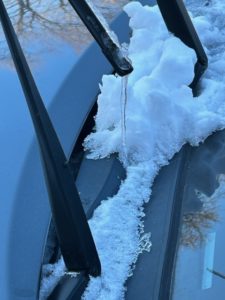 Innocuous enough. Ice.
Innocuous enough. Ice.
Just water that has reached the point of freezing, changing its defining characteristic from liquid to solid, fluid and amorphous to weighty and hard-edged.
Sometimes sharp or slippery, often difficult to see, thin layers or “coats” of ice can be challenging to traverse without losing your balance.
There was an ice storm the other week. I didn’t know whether to be grateful for the continued above average winter temperatures, which keeps my heating bill within the stratosphere, or to bemoan how difficult the event made driving.
After completing scheduled appointments and errands, a visit to the dentist and stop at CVS to pick up rock salt for my front stairs, at around four, I parked my car in front of my building. It seemed like it would make getting to and from my vehicle less treacherous than taking the frozen back stairs.
I reasoned that taking a trip outside my home was unnecessary. I had plenty of food in the freezer and a surplus of agreeable distractions, things to read and movies to stream.
Yet, twenty-four hours later, I found myself leaning over my car, trying to chisel and pick away at the ice on my windshield. It took several minutes just to open the doors. They had frozen shut.
After I gained entry, I selected DEFROST and dialed the fan up to high. I sat in the driver’s seat and watched the shifting of ice on the glass until the wiper blades were free to rock.
Did I really want to drive? Was it that important to pick up a book from the library and drop something off at the post office?
I watched the ice on the windshield turn back into water. Slow moving at first, droplets from the mini glacier on my car’s roof picked up speed as they traveled downward and disappeared into the hood.
I considered that you had to respect the potential danger of ice; it sharpness, its ability to make another surface too slick to stand on, how it surrenders to gravity on its own time.
It can be shocking, although it shouldn’t be unexpected, when ice breaks away and falls from the roof of a building or melts and draws an ever-widening fissure on a pond. I read that five people from North America die while ice fishing almost every winter.
The transformative nature of water is considerable, and it’s a great metaphor for every one of us.
We can all change. Even radically, We change how we look at our own experiences all the time.
There’s a special kind of beauty in ice — its ephemeral nature, how it lets go on its own time, how it ca be shaped into so many different forms. Anyone who has seen ice sculptures can attest to this.
From the driver’s seat of my car, with the heater on full blast, I watched the ice on my windshield melt and move about in a dance of life.
I witnessed the back and forth we all go through between seeing ourselves as individuals and just flowing as part of Consciousness, Oneness.
As separate beings, we can engage our talents and feed our interests. We can write poems or repair cars.
As ice turns back into water or vapor, adding humidity to the air or clouds to the horizon, we can see one kind of beauty. When we think from the perspective of life itself, not just someone who has life, we can appreciate a different kind of beauty.
One form is not better than the other. We don‘t have to choose a preference between ice or water, between seeing things from our unique pair of eyes or from a more impartial and dispassionate perspective.
Our nature involves experiencing both, transforming from one to the other all the time.
The transformation from water to ice, or from ice to water, is no small thing


Leave a comment